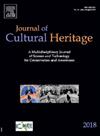一种评估砂岩遗产风化程度的空气耦合超声新技术
IF 3.3
2区 综合性期刊
0 ARCHAEOLOGY
引用次数: 0
摘要
在石质文物风化检测领域,普遍采用凝胶耦合和非耦合接触式超声检测。然而,这些技术存在固有的挑战,例如在接触式超声检测过程中,耦合的潜在污染和残余损伤的风险。空气耦合超声检测的出现为石质文物的风化检测提供了一种更安全的替代方法,但其在风化程度检测中的稳定性和适用性有待进一步验证。本研究以云冈石窟砂岩为研究对象,进行了冻融循环和酸浸条件下的模拟风化试验。建立了空气耦合超声测试系统,根据得到的原始波形计算了砂岩试样的超声声速。同时,对不同风化程度的砂岩试样进行了凝胶耦合、接触式超声及多种常用无损检测技术的测试;采用最小二乘回归模型和相关分析方法,分析了超声波波速值及其随风化过程的变化趋势。结果表明:空气耦合超声在重复检测中的波速色散明显低于其他两种传统超声检测技术;所得波速更符合风化程度的变化趋势,在石质文物风化程度检测中具有较高的适用性;与其他无损检测结果的相关性较强。综上所述,空气耦合超声检测技术可以提供更加准确、安全、有效的风化检测数据,在石质文物检测中具有较强的适用性和广阔的应用前景,为石质文物保护提供了重要支撑。本文章由计算机程序翻译,如有差异,请以英文原文为准。
A novel air-coupled ultrasonic technique for assessing the weathering degree of sandstone heritage
In the realm of stone cultural heritage weathering detection, both gel-coupled and non-coupled contact ultrasonic testing are prevalently employed. However, these techniques harbor inherent challenges, such as potential contamination from coupled and the risk of relic damage during contact ultrasonic testing. The advent of air-coupled ultrasonic testing presents a safer alternative for weathering detection of stone cultural heritage, though its stability and applicability in weathering degree detection require further validation. In this research, using sandstone samples from the Yungang Grottoes, we conducted simulated weathering tests under freeze-thaw cycles and acid soaking conditions. An air-coupled ultrasonic test system was set up, and the ultrasonic velocity of sandstone samples was calculated based on the obtained original waveforms. Meanwhile, the samples of sandstone with different weathering degrees were tested by gel-coupled, contact ultrasonic testing and many common non-destructive testing techniques; the value of ultrasonic wave velocity and its change trend with weathering process were analyzed by means of least square regression model and correlation analysis. The results revealed that the wave velocity dispersion of air-coupled ultrasonic in repeated detection is significantly lower than that of the other two traditional ultrasonic detection techniques; the obtained wave velocity is more consistent with the change trend of weathering degree, which has high applicability in the weathering degree detection of stone cultural heritage; the correlation with other non-destructive testing results is stronger. In summary, the air-coupled ultrasonic test technology can provide more accurate, safe, and effective weathering detection data, showcasing strong applicability and broad application prospects in the detection of stone cultural heritage, thus offering important support for their protection.
求助全文
通过发布文献求助,成功后即可免费获取论文全文。
去求助
来源期刊

Journal of Cultural Heritage
综合性期刊-材料科学:综合
CiteScore
6.80
自引率
9.70%
发文量
166
审稿时长
52 days
期刊介绍:
The Journal of Cultural Heritage publishes original papers which comprise previously unpublished data and present innovative methods concerning all aspects of science and technology of cultural heritage as well as interpretation and theoretical issues related to preservation.
 求助内容:
求助内容: 应助结果提醒方式:
应助结果提醒方式:


